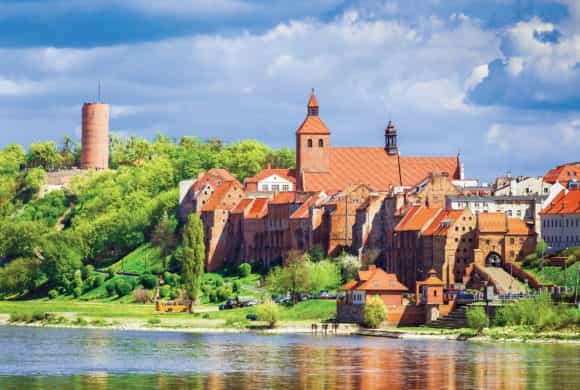The church was built in the Gothic style, facing the east, featuring the nave and two side aisles. The chancel is closed from three sides and has a sacristy in the north. The nave is taller than the side aisles. Statues of Saints Andrew, Paul, Peter and Jude Thaddaeus are seen in the lower story of the high altar ; statues of Saint John Nepomucene, Gregory the Great, Nicholas and Francis Xavier – in the upper story; whereas a statue of St. Mary and Child is seen in the finial. The central field of the altar features a painting of St. Nicholas made by Jerzy Hoppen in 1950; the upper story – a depiction of the Holy Trinity by Leonard Torwirt dating from 1950;and a image of St. George in the finial. In front of the chancel, on the right, there is a 13th-century baptismal font in the Gotland style, decorated with floral ornaments, dragons and mascarons, with a Romanesque granite goblet. The side altars, designed by L.Torwirt in 1954, feature components dating from the turn of the 18th- century. The northern aisle presents the preserved central part of the altar and a couple of openwork columns, and a predella with a painted scene of the Annunciation of the Blessed Virgin Mary as well as statues of St. John the Evangelist and St.Luke. In the middle of the altar, there is a 17th-century painting of St.Mary and Child in a silver, embossed robe dating from the 18th-century, decorated with two gilded crowns consecrated by Pope John Paul II on March 9, 2002.
Other historic objects seen in the church include 17th-century paintings depicting the Virgin and Child with St. Anne, St. Nicholas painted on board, the Coronation of the Blessed Virgin Mary which accordind to legend comes from the castle chapel, 18th- century image of St. Anthony in the neogotic frame, and two mediewal, granit baptismal fonts dating from the 13th/14 th centuries in the vestibule and under the steeple. The steeple blends in the nave. Over the nave, from the east, there is with an octagonal lantern. Construction of the church started a fleche with an octagonal lantern. Construction of the church started in 1286. The chancel was built before 1310. The nave was built around the mid-14th century, whereas the side aisles and steeple date from the turn of the 15th century. Sessions of the general council were held in the church in the 16th century. In 1572-1598, the church was taken over by Protestants. After 1620, the burial chapels of the Kostka family and the octagonal chapel of the Działyński family were added from the nord. Since 1622 until construction of their own church, the chapel had been owned by the Jesuits. A chapel was added from the south in 1632;it was propably reconstructed as today’s vestibule. During the Swedish occupation in 1655-1659 the church was once again a Protestant place of worship. During warfare, it was damaged by fire in 1659. In 1728, the Baroque high altar was added to the throughly renovated Fara Church. In 1738, the roof on the tower was replaced with a Baroque dome, and a fleche was built in 1769.
In the same century, the terracotta statues from the old castle chapel were built in the western part of the steeple, from the direction of the river. At the turn of the 19th century, the Chapel of St. Michael the Archangel, as well as the chapels of the Kostka and Działyński families were pulled down. In 1939, polychromes-fragments of Gothic murals were unveiled. The church was consumed by fire during the siege of the city in 1945. After the war, the steeple was rebuilt. In addition, the church regained the bells dating from 1482 and 1777 that were taken to Germany. In 1950-56, the altars were restored after war damages. On July 20, 2010 Pope Benedict XVI raised the church to the status of a Minor Basilica.





